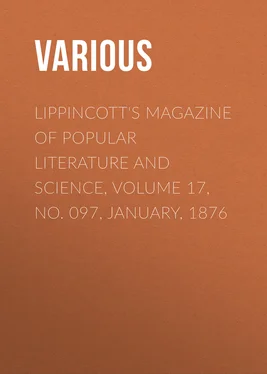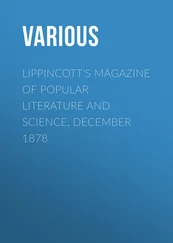Various - Lippincott's Magazine of Popular Literature and Science, Volume 17, No. 097, January, 1876
Здесь есть возможность читать онлайн «Various - Lippincott's Magazine of Popular Literature and Science, Volume 17, No. 097, January, 1876» — ознакомительный отрывок электронной книги совершенно бесплатно, а после прочтения отрывка купить полную версию. В некоторых случаях можно слушать аудио, скачать через торрент в формате fb2 и присутствует краткое содержание. Издательство: Иностранный паблик, Жанр: foreign_antique, periodic, foreign_edu, на английском языке. Описание произведения, (предисловие) а так же отзывы посетителей доступны на портале библиотеки ЛибКат.
- Название:Lippincott's Magazine of Popular Literature and Science, Volume 17, No. 097, January, 1876
- Автор:
- Издательство:Иностранный паблик
- Жанр:
- Год:неизвестен
- ISBN:нет данных
- Рейтинг книги:3 / 5. Голосов: 1
-
Избранное:Добавить в избранное
- Отзывы:
-
Ваша оценка:
- 60
- 1
- 2
- 3
- 4
- 5
Lippincott's Magazine of Popular Literature and Science, Volume 17, No. 097, January, 1876: краткое содержание, описание и аннотация
Предлагаем к чтению аннотацию, описание, краткое содержание или предисловие (зависит от того, что написал сам автор книги «Lippincott's Magazine of Popular Literature and Science, Volume 17, No. 097, January, 1876»). Если вы не нашли необходимую информацию о книге — напишите в комментариях, мы постараемся отыскать её.
Lippincott's Magazine of Popular Literature and Science, Volume 17, No. 097, January, 1876 — читать онлайн ознакомительный отрывок
Ниже представлен текст книги, разбитый по страницам. Система сохранения места последней прочитанной страницы, позволяет с удобством читать онлайн бесплатно книгу «Lippincott's Magazine of Popular Literature and Science, Volume 17, No. 097, January, 1876», без необходимости каждый раз заново искать на чём Вы остановились. Поставьте закладку, и сможете в любой момент перейти на страницу, на которой закончили чтение.
Интервал:
Закладка:
Emerging on the great gardens, forty four acres in extent, we find ourselves on broad walks laid out with mathematical regularity, and edged by noble masses of yew, holly, horse-chestnut, etc. almost as rectangular and circular. We are here struck with the great advantage derived in landscape gardening from the rich variety of large evergreens possible in the climate of Britain. The holly, unknown as an outdoor plant in this country north of Philadelphia, is at home in the north of Scotland, eighteen degrees nearer the pole. We are more fortunate with the Conifers, many of the finest of which family are perfectly hardy here. But we miss the deodar cedar, the redwood and Washingtonia of California, and the cedar of Lebanon. These, unless perhaps the last, cannot be depended on much north of the latitude of the Magnolia grandiflora. They thrive all over England, with others almost as beautiful, and as delicate north of the Delaware. Of the laurel tribe, also hardy in England, our Northern States have but a few weakly representatives. So with the Rhododendra.
When, tired of even so charming a scene of arboreal luxury, we knock at the Flower-Pot gate to the left of the palace, and are admitted into the private garden, we make the acquaintance of another stately stranger we have had the honor at home of meeting only under glass. This is the great vine, ninety years or a hundred old, of the Black Hamburg variety. It does not cover as much space as the Carolina Scuppernong—the native variety that so surprised and delighted Raleigh's Roanoke Island settlers in 1585—often does. But its bunches, sometimes two or three thousand in number, are much larger than the Scuppernong's little clumps of two or three. They weigh something like a pound each, and are thought worthy of being reserved for Victoria's dessert. Her own family vine has burgeoned so broadly that three thousand pounds of grapes would not be a particularly large dish for a Christmas dinner for the united Guelphs.
We must not forget the Labyrinth, "a mighty maze, but not without a plan," that has bewildered generations of young and old children since the time of its creator, William of Orange. It is a feature of the Dutch style of landscape gardening imprinted by him upon the Hampton grounds. He failed to impress a like stamp upon that chaos of queer, shapeless and contradictory means to beneficent ends, the British constitution.
Hampton Court, notwithstanding the naming of the third quadrangle the Fountain Court, and the prominence given to a fountain in the design of the principal grounds, is not rich in waterworks. Nature has done a good deal for it in that way, the Thames embracing it on two sides and the lowness of the flat site placing water within easy reach everywhere. This superabundance of the element did not content the magnificent Wolsey. He was a man of great ideas, and to secure a head for his jets he sought an elevated spring at Combe Wood, more than two miles distant. To bring this supply he laid altogether not less than eight miles of leaden pipe weighing twenty-four pounds to the foot, and passing under the bed of the Thames. Reduced to our currency of to-day, these conduits must have cost nearly half a million of dollars. They do their work yet, the gnawing tooth of old Edax rerum not having penetrated far below the surface of the earth. Better hydraulic results would now be attained at a considerably reduced cost by a steam-engine and stand-pipe. At the beginning of the sixteenth century this motor was not even in embryo, unless we accept the story of Blasco de Garay's steamer that manoeuvred under the eye of Charles V. as fruitlessly as Fitch's and Fulton's before Napoleon. Coal, its dusky pabulum, was also practically a stranger on the upper Thames. The ancient fire-dogs that were wont to bear blazing billets hold their places in the older part of the palace.
Crossing the Kingston road, which runs across the peninsula and skirts the northern boundary of Hampton Park, we get into its continuation, Bushy Park. This is larger than the chief enclosure, but less pretentious. We cease to be oppressed by the palace and its excess of the artificial. The great avenues of horse-chestnut, five in number, and running parallel with a length of rather more than a mile and an aggregate breadth of nearly two hundred yards, are formal enough in design, but the mass of foliage gives them the effect of a wood. They lead nowhere in particular, and are flanked by glades and copses in which the genuinely rural prevails. Cottages gleam through the trees. The lowing of kine, the tinkling of the sheep-bell, the gabble of poultry, lead you away from thoughts of prince and city. Deer domesticated here since long before the introduction of the turkey or the guinea-hen bear themselves with as quiet ease and freedom from fear as though they were the lords of the manor and held the black-letter title-deeds for the delicious stretch of sward over which they troop. Less stately, but scarce more shy, indigenes are the hares, lineal descendants of those which gave sport to Oliver Cromwell. When that grim Puritan succeeded to the lordship of the saintly cardinal, he was fain, when the Dutch, Scotch and Irish indulged him with a brief chance to doff his buff coat, to take relaxation in coursing. We loiter by the margin of the ponds he dug in the hare-warren, and which were presented as nuisances by the grand jury in 1662. The complaint was that by turning the water of the "New River" into them the said Oliver had made the road from Hampton Wick boggy and unsafe. Another misdemeanor of the deceased was at the same time and in like manner denounced. This was the stopping up of the pathway through the warren. The palings were abated, and the path is open to all nineteenth-century comers, as it probably will be to those of the twentieth, this being a land of precedent, averse to change. We may stride triumphantly across the location of the Cromwellian barricades, and not the less so, perhaps, for certain other barricades which he helped to erect in the path of privilege.
Directing our steps to the left, or westward, we again reach the river at the town of Hampton. It is possessed of pretty water-views, but of little else of note except the memory and the house of Garrick. Hither the great actor, after positively his last night on the stage, retired, and settled the long contest for his favor between the Muses of Tragedy and Comedy by inexorably turning his back on both. He did not cease to be the delight of polished society, thanks to his geniality and to literary and conversational powers capable of making him the intimate of Johnson and Reynolds. More fortunate in his temperament and temper than his modern successor, Macready, he never fretted that his profession made him a vagabond by act of Parliament, or that his adoption of it in place of the law had prevented his becoming, by virtue of the same formal and supreme stamp, the equal of the Sampson Brasses plentiful in his day as in ours among their betters of that honorable vocation. His self-respect was of tougher if not sounder grain. "Worth makes the man, and want of it the fellow," was the motto supplied him by his friend and neighbor, Pope, but obeyed long before he saw it in the poetic form.
Garrick's house is separated from its bit of "grounds," which run down to the water's edge, by the highway. It communicates with them by a tunnel, suggested by Johnson. It was not a very novel suggestion, but the excavation deserves notice as probably the one engineering achievement of old Ursus major. We may fancy the Titan of the pen and the tea-table, in his snuffy habit as he lived and as photographed by Boswell, Mrs. Thrale, Fanny Burney, and their epitomizer Macaulay, diving under the turnpike and emerging among the osiers and water-rats to offer his orisons at the shrine of Shakespeare. For, in the fashion of the day, Garrick erected a little brick "temple," and placed therein a statue of the man it was the study of his life to interpret. The temple is there yet. The statue, a fine one by Roubillac, now adorns the hall of the British Museum, a much better place for it. Garrick, and not Shakespeare, is the genius loci .
Читать дальшеИнтервал:
Закладка:
Похожие книги на «Lippincott's Magazine of Popular Literature and Science, Volume 17, No. 097, January, 1876»
Представляем Вашему вниманию похожие книги на «Lippincott's Magazine of Popular Literature and Science, Volume 17, No. 097, January, 1876» списком для выбора. Мы отобрали схожую по названию и смыслу литературу в надежде предоставить читателям больше вариантов отыскать новые, интересные, ещё непрочитанные произведения.
Обсуждение, отзывы о книге «Lippincott's Magazine of Popular Literature and Science, Volume 17, No. 097, January, 1876» и просто собственные мнения читателей. Оставьте ваши комментарии, напишите, что Вы думаете о произведении, его смысле или главных героях. Укажите что конкретно понравилось, а что нет, и почему Вы так считаете.












